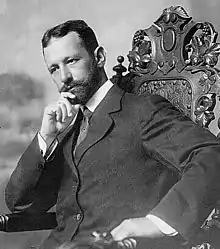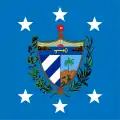Mario García Menocal
Aurelio Mario Gabriel Francisco García Menocal y Deop (December 17, 1866 – September 7, 1941) was the 3rd President of Cuba, serving from 1913 to 1921. His terms as president saw Cuba's participation in World War I.
Mario García Menocal | |
|---|---|
 Mario García Menocal, c. 1912 | |
| 3rd President of Cuba | |
| In office 20 May 1913 – 20 May 1921 | |
| Vice President | Enrique José Varona and Emilio Núñez |
| Preceded by | José Miguel Gómez |
| Succeeded by | Alfredo Zayas |
| Personal details | |
| Born | December 17, 1866 Jagüey Grande, Matanzas, Spanish Cuba |
| Died | September 7, 1941 (aged 74) Santiago de Cuba, Cuba |
| Nationality | |
| Political party | Conservative Party |
| Spouse(s) | Mariana Seva y Rodriguez |
| Children | Mario, Raul, and Georgina Garcia-Menocal Seva |
| Alma mater | Cornell University |
| Occupation | Attorney |
Youth
Born in Jagüey Grande, Matanzas, Cuba, García Menocal was thirteen when he was sent to boarding schools in the United States, first at the Chappaqua Mountain Institute in New York, and later at the Maryland Agricultural College. In 1884, he then went to Cornell University where he graduated in 1888 from the School of Engineering. While at Cornell University, he was a member of the Delta Kappa Epsilon fraternity (Delta Chi Chapter).[1] As a young man he was involved in Cuba's fight for independence from Spain. When Cuba did receive independence following the Spanish–American War, García Menocal became a leading conservative politician.
Time in office
Mario García Menocal was elected President in 1912 and became known for his strong support of business and corporations. He was reelected in 1916, though the election was challenged by the liberals. In perhaps his most notable action, García Menocal authorized Cuba's declaration of war against the German Empire on April 7, 1917, entering World War I a day after the United States. This was believed by many to be an attempt to get the United States to give more support to his government. In December, war was also declared against Austria-Hungary.
While in office, García Menocal hosted the 1920 Delta Kappa Epsilon National Convention,[2] the first international fraternity conference outside the US, which took place in Cuba. Private trains were hired from New England to Florida where the invited men and their families could travel in comfort and style, and upon arrival in Cuba, each man was gifted a gold-trimmed box of cigars. García Menocal's hospitality is still remembered in the fraternity to this day. He was responsible for creating the Cuban Peso, until his presidency Cuba used both the Spanish Real and US Dollar.
Later life
After his presidency, García Menocal continued to be involved in politics, running for President again in 1924. He attempted a revolution in 1931 and went into exile in the United States when it failed. After less than five years he returned to Cuba and ran for President a final time in 1936. He died in Santiago de Cuba, Cuba.
Family
García Menocal was married to Mariana Seva y Rodríguez and they had three children, Mario (who married Hortensia Almagro), Raúl (who married Perlita Fowler) and Georgina García Menocal y Seva (who married Eugenio Sardina).
Notes and references
- Fogel (25 Nov 2005) p. 27 and passim
- Fogel (25 Nov 2005) p. 66
Sources
- Argote-Freyre, Frank (2006). Fulgencio Batista: From Revolutionary to Strongman. New Brunswick, New Jersey: Rutgers University Press. ISBN 978-0-8135-3701-6. OCLC 59223855.
- Fogle, Homer William Jr. (25 Nov 2005). The Deke House at Cornell: A Concise History of the Delta Chi Chapter of Delta Kappa Epsilon, 1870–1930. Cf. pp. 27, 57, 60, 64, 66–69. Retrieved 2010-12-02.
- Minot, John Clair (February 1921). "The Convention in Havana", Delta Kappa Epsilon Quarterly, XXXIX, 1, p. 1–25.
- Otero, Juan Joaquin (1954). Libro De Cuba, Una Enciclopedia Ilustrada Que Abarca Las Artes, Las Letras, Las Ciencias, La Economia, La Politica, La Historia, La Docencia, Y ElProgreso General De La Nacion Cubana - Edicion Conmemorative del Cincuentenario de la Republica de Cuba, 1902-1952 (in Spanish).
External links
 Media related to Mario García Menocal at Wikimedia Commons
Media related to Mario García Menocal at Wikimedia Commons
| Political offices | ||
|---|---|---|
| Preceded by José Miguel Gómez |
President of Cuba 1913–1921 |
Succeeded by Alfredo Zayas |
